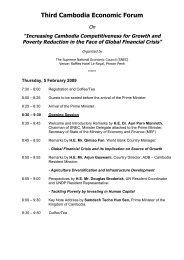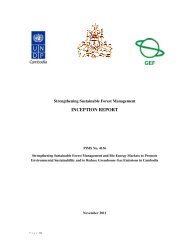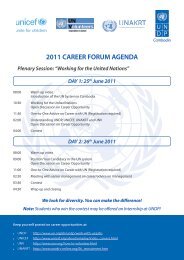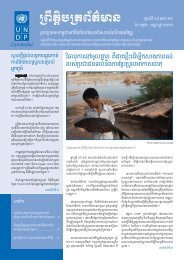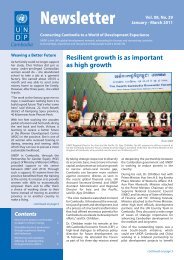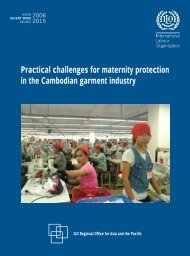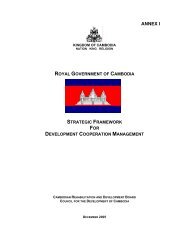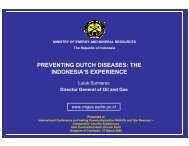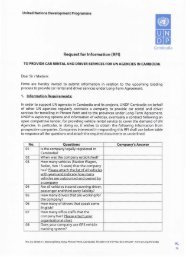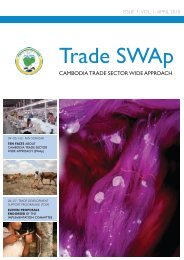UN Analysis Final.pdf - United Nations in Cambodia
UN Analysis Final.pdf - United Nations in Cambodia
UN Analysis Final.pdf - United Nations in Cambodia
Create successful ePaper yourself
Turn your PDF publications into a flip-book with our unique Google optimized e-Paper software.
VII<br />
YOUTH AND<br />
VULNERABILITY<br />
Changes brought about by globalization affect <strong>Cambodia</strong>n young people <strong>in</strong> a number of ways,<br />
compromis<strong>in</strong>g their human rights and creat<strong>in</strong>g many risks and vulnerabilities on one hand while<br />
open<strong>in</strong>g opportunities for their advancement as <strong>in</strong>dividuals and as a group on the other. Regional<br />
<strong>in</strong>tegration, advanced use of technology, the <strong>in</strong>creas<strong>in</strong>g global demand for skilled labour, and chang<strong>in</strong>g<br />
liv<strong>in</strong>g standards have made both negative and positive impacts on young people. Youths are the most<br />
affected sector of society when it comes to cop<strong>in</strong>g with rapid economic growth and social change.<br />
Inadequate vocational skills among youth reduce their employability, <strong>in</strong>crease the probability of their leav<strong>in</strong>g<br />
school early, and contribute to the grow<strong>in</strong>g number of under-tra<strong>in</strong>ed youths, marg<strong>in</strong>aliz<strong>in</strong>g them and<br />
underm<strong>in</strong><strong>in</strong>g their entrepreneurial competitiveness (Brewer 2004). That young <strong>Cambodia</strong>ns lack life and<br />
livelihood skills to cope with the challenges of globalization is seen as a major source of youth vulnerability.<br />
Other issues associated with poverty, poor liv<strong>in</strong>g conditions, poor nutrition, and ill health compound<br />
the vulnerability of youth. Poor children live <strong>in</strong> conditions of particular vulnerability. Their future is often<br />
compromised by shocks and stresses that hit their households when they are at a young age. Lack of<br />
adequate nutrition <strong>in</strong> their early years impairs their physical and mental development for the rest of their<br />
life. The lack of education and tra<strong>in</strong><strong>in</strong>g, which are essential components of measures to address the<br />
challenges faced by poor children, is l<strong>in</strong>ked to <strong>in</strong>creased vulnerability among youth. A low level of formal<br />
school education – brought about by parents withdraw<strong>in</strong>g adolescents and youths from school, which<br />
is a typical (but unsusta<strong>in</strong>able) cop<strong>in</strong>g mechanism – has severe consequences for future youth employment<br />
opportunities <strong>in</strong> a rapidly chang<strong>in</strong>g labour market (Gall<strong>in</strong>a and Mas<strong>in</strong>a 2002).<br />
Although <strong>Cambodia</strong> has emerged from a period of <strong>in</strong>ternal conflict, it is still marked by a “culture of violence”<br />
directed primarily at women <strong>in</strong> the form of domestic violence, traffick<strong>in</strong>g of women and rape (Ing<br />
Kantha, 2006). Unemployment, a lack of access to <strong>in</strong>formation, substance abuse, and parental neglect<br />
are among the problems confront<strong>in</strong>g youth. Those with disabilities face even greater competition from<br />
young unemployed school-leavers when search<strong>in</strong>g for jobs, often result<strong>in</strong>g <strong>in</strong> negative attitudes and<br />
mistaken assumptions on the part of employers about their work capacity.<br />
This chapter explores the situation of <strong>Cambodia</strong>’s vulnerable youth <strong>in</strong> relation to their environment, which<br />
largely part contributes to their vulnerability. It also presents the key elements and gaps that can serve as<br />
a basis for recommendations of how to address weaknesses and strengthen good practices <strong>in</strong> respond<strong>in</strong>g<br />
to the problems of vulnerable youth. Based on this situation analysis, the study also identifies opportunities<br />
for improv<strong>in</strong>g the process of awareness rais<strong>in</strong>g and advocacy on youth and vulnerability. Key issues discussed<br />
<strong>in</strong> this section are: the current laws, policies and programmes that respond to the unfavourable conditions<br />
of youths; the enabl<strong>in</strong>g environment and support available from <strong>in</strong>ternational organizations; and the<br />
engagement of NGOs. The last section of this chapter discusses issues <strong>in</strong>clud<strong>in</strong>g the impact of poverty,<br />
education, migration, violence and abuse, and other related concerns aris<strong>in</strong>g from the effects of rapid<br />
social change.<br />
Situation <strong>Analysis</strong> of Youth <strong>in</strong> <strong>Cambodia</strong><br />
79




